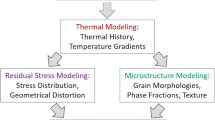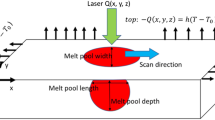Abstract
Although the material microstructure attributes play an important role in the mechanical properties of the additively manufactured (AM) part, their impact is largely ignored in the mechanics modeling of AM processes. A physics-based mechanical threshold stress (MTS) model is proposed to consider the material internal attributes, such as grain size and dislocation to dislocation barrier during simulation of the material flow stress and deformation. This model is based on the dislocation dynamics and thermal activation theory with a combination of three main components of athermal stress, thermal stress, and threshold stress. The MTS flow stress model is embedded into a fully coupled thermo-mechanical incremental plasticity model to predict the residual stress during AM processes from the prediction of temperature field and associated thermal stresses. The experimental measurements of residual stress are conducted on additively manufactured Ti-6Al-4 V samples for the model validation. The proposed model provides insight into the impact of microstructure on residual stress prediction in the additive manufacturing process modeling.




Similar content being viewed by others
References
Lewis GK, Schlienger E (2000) Practical considerations and capabilities for laser assisted direct metal deposition. Mater Des 21(4):417–423
Chen B, Su Y, Xie Z, Tan C, Feng J (2020) Development and characterization of 316L/Inconel625 functionally graded material fabricated by laser direct metal deposition. Opt Laser Technol 123:105916
Tabei A et al (2019) Modeling of texture development in additive manufacturing of Ni-based superalloys. The International Journal of Advanced Manufacturing Technology 103(1–4):1057–1066
Popovich V et al (2017) Functionally graded Inconel 718 processed by additive manufacturing: crystallographic texture, anisotropy of microstructure and mechanical properties. Mater Des 114:441–449
Ali H, Ma L, Ghadbeigi H, Mumtaz K (2017) In-situ residual stress reduction, martensitic decomposition and mechanical properties enhancement through high temperature powder bed pre-heating of selective laser melted Ti6Al4V. Mater Sci Eng A 695:211–220
Vastola G, Zhang G, Pei QX, Zhang YW (2016) Controlling of residual stress in additive manufacturing of Ti6Al4V by finite element modeling. Addit Manuf 12:231–239
Chen Q, Liu J, Liang X, To AC (2020) A level-set based continuous scanning path optimization method for reducing residual stress and deformation in metal additive manufacturing. Comput Methods Appl Mech Eng 360:112719
Promoppatum P, Yao S-C (2020) Influence of scanning length and energy input on residual stress reduction in metal additive manufacturing: numerical and experimental studies. J Manuf Process 49:247–259
Chen Y, Sun H, Li Z, Wu Y, Xiao Y, Chen Z, Zhong S, Wang H (2020) Strategy of residual stress determination on selective laser melted Al alloy using XRD. Materials 13(2):451
Tridello A, Fiocchi J, Biffi CA, Chiandussi G, Rossetto M, Tuissi A, Paolino DS (2020) Effect of microstructure, residual stresses and building orientation on the fatigue response up to 109 cycles of an SLM AlSi10Mg alloy. Int J Fatigue 137:105659
Mirkoohi E et al (2020) Analytical mechanics modeling of residual stress in laser powder bed considering flow hardening and softening. Int J Adv Manuf Technol:1–14
Neuvonen R, Skriko T, Björk T (2020) Use of the quasi-static Johnson-Cook model in the failure assessment of tensile specimens with metallurgical constraints. Eur J Mechan A/Solids 82:104011
Cao J et al (2020) A strain rate dependent fracture model of 7050 aluminum alloy. Metals 10(1):3
Cao Y, Zhen Y, Song M, Yi H, Li F, Li X (2020) Determination of Johnson-Cook parameters and evaluation of Charpy impact test performance for X80 pipeline steel. Int J Mech Sci 179:105627
Calamaz M, Coupard D, Girot F (2008) A new material model for 2D numerical simulation of serrated chip formation when machining titanium alloy Ti–6Al–4V. Int J Mach Tools Manuf 48(3–4):275–288
Zhang X, Shivpuri R, Srivastava A (2014) Role of phase transformation in chip segmentation during high speed machining of dual phase titanium alloys. J Mater Process Technol 214(12):3048–3066
Mecking H, Kocks U (1981) Kinetics of flow and strain-hardening. Acta Metall 29(11):1865–1875
Kocks, U., Laws for work-hardening and low-temperature creep. 1976
Varshni Y (1970) Temperature dependence of the elastic constants. Phys Rev B 2(10):3952–3958
Follansbee P, Gray G (1989) An analysis of the low temperature, low and high strain-rate deformation of Ti− 6Al− 4V. Metall Trans A 20(5):863–874
Mahdavi M et al (2020) Prediction of the deformation behavior of a selective laser-melted Ti-6Al-4V alloy as a function of process parameters. Int J Adv Manuf Technol:1–8
Carroll BE, Palmer TA, Beese AM (2015) Anisotropic tensile behavior of Ti–6Al–4V components fabricated with directed energy deposition additive manufacturing. Acta Mater 87:309–320
Mirkoohi E, Seivers DE, Garmestani H, Liang SY (2019) Heat source modeling in selective laser melting. Materials 12(13):2052
Mirkoohi E, Sievers DE, Garmestani H, Chiang K, Liang SY (2019) Three-dimensional semi-elliptical modeling of melt pool geometry considering hatch spacing and time spacing in metal additive manufacturing. J Manuf Process 45:532–543
Mirkoohi E, Sievers DE, Liang SY Effect of time spacing and hatch spacing on thermal material properties and melt pool geometry in additive manufacturing of S316L. In International Manufacturing Science and Engineering Conference. 2019. Am Soc Mech Eng
Mirkoohi E, Ning J, Bocchini P, Fergani O, Chiang KN, Liang S (2018) Thermal modeling of temperature distribution in metal additive manufacturing considering effects of build layers, latent heat, and temperature-sensitivity of material properties. J Manuf Mater Process 2(3):63
Mirkoohi E, Sievers DE, Garmestani H, Liang SY (2020) Thermo-mechanical modeling of thermal stress in metal additive manufacturing considering elastoplastic hardening. CIRP J Manuf Sci Technol 28:52–67
Mirkoohi E, Dobbs JR, Liang SY (2020) Analytical mechanics modeling of in-process thermal stress distribution in metal additive manufacturing. J Manuf Process 58:41–54
McDowell D (1997) An approximate algorithm for elastic-plastic two-dimensional rolling/sliding contact. Wear 211(2):237–246
Mirkoohi E, Dobbs JR, Liang SY (2020) Analytical modeling of residual stress in direct metal deposition considering scan strategy. Int J Adv Manuf Technol 106(9–10):4105–4121
Mirkoohi E, Tran HC, Lo YL, Chang YC, Lin HY, Liang SY (2020) Analytical modeling of residual stress in laser powder bed fusion considering Part’s boundary condition. Crystals 10(4):337
Nadammal N, Kromm A, Saliwan-Neumann R, Farahbod L, Haberland C, Portella PD (2018) Influence of support configurations on the characteristics of selective laser-melted inconel 718. JOM 70(3):343–348
Prevey PS (1986) X-ray diffraction residual stress techniques, ASM Handbook, vol 10. ASM International, pp 380–392
Davis JR (2000) Nickel, cobalt, and their alloys. ASM international
Li JJ, Johnson WL, Rhim W-K (2006) Thermal expansion of liquid Ti–6Al–4V measured by electrostatic levitation. Appl Phys Lett 89(11):111913
Jamshidinia M, Kong F, Kovacevic R (2013) Numerical modeling of heat distribution in the electron beam melting® of Ti-6Al-4V. J Manuf Sci Eng 135(6)
Heigel J, Michaleris P, Reutzel EW (2015) Thermo-mechanical model development and validation of directed energy deposition additive manufacturing of Ti–6Al–4V. Addit Manuf 5:9–19
Pan Z et al (2019) Residual stress prediction based on MTS model during machining of Ti-6Al-4V. Proc Inst Mech Eng C J Mech Eng Sci 233(11):3743–3750
Kruth J-P, Deckers J, Yasa E, Wauthlé R (2012) Assessing and comparing influencing factors of residual stresses in selective laser melting using a novel analysis method. Proc Inst Mech Eng B J Eng Manuf 226(6):980–991
Gusarov A, Pavlov M, Smurov I (2011) Residual stresses at laser surface remelting and additive manufacturing. Phys Procedia 12:248–254
Availability of data and material
Not applicable.
Author information
Authors and Affiliations
Contributions
Elham Mirkoohi: conceptualization, methodology, experiments, validation, modeling, investigation, writing original draft preparation, review and editing, and visualization. Mostafa Mahdavi: methodology, modeling, writing original draft preparation, and review and editing. Dongsheng Li: building AM samples, review the manuscript. Hamid Garmestani: review the manuscript, supervision. Steven Liang: review and editing, supervision, resources.
Corresponding author
Ethics declarations
Conflicts of interest/competing interests
There is no conflict of interests.
Code availability
Not applicable.
Additional information
Publisher’s note
Springer Nature remains neutral with regard to jurisdictional claims in published maps and institutional affiliations.
Rights and permissions
About this article
Cite this article
Mirkoohi, E., Mahdavi, M., Li, D. et al. Microstructure affected residual stress prediction based on mechanical threshold stress in direct metal deposition of Ti-6Al-4 V. Int J Adv Manuf Technol 112, 1705–1712 (2021). https://doi.org/10.1007/s00170-020-06526-w
Received:
Accepted:
Published:
Issue Date:
DOI: https://doi.org/10.1007/s00170-020-06526-w




